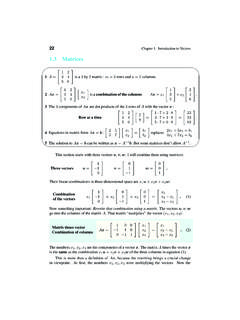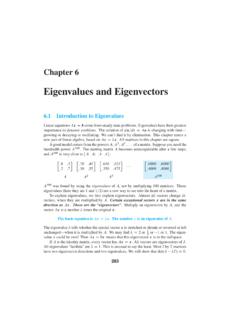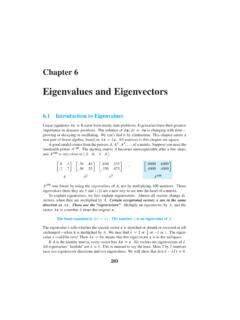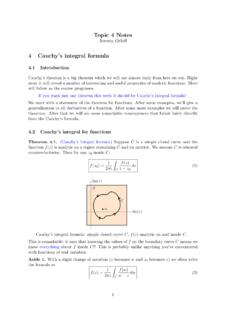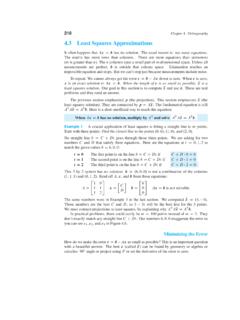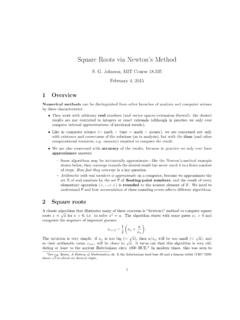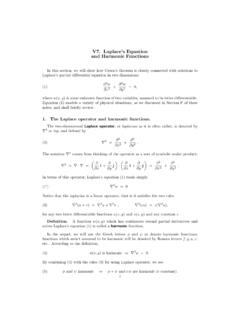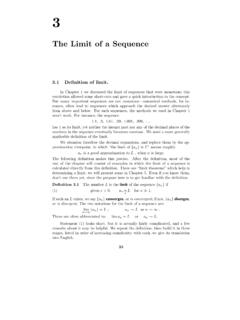Transcription of A FRIENDLY INTRODUCTION TO GROUP THEORY
1 A FRIENDLY INTRODUCTION TO GROUP THEORYJAKE cares?You do, prefrosh. If you re a math major, then you probably want to pass Math you re a chemistry major, then you probably want to take that one chem class Iheard involves representation THEORY . If you re a physics major, then at some pointyou might want to know what the Standard Model is. And I ll bet at least a fewof you CS majors care at least a little bit about cryptography. Anyway, Wikipediathinks it s useful to know some basic GROUP THEORY , and I think I agree. It s also funand I promise it isn t very is a GROUP ?I m about to tell you what a GROUP is, so brace yourself for disappointment.
2 It sbound to be a somewhat anticlimactic experience for both of us: I type out a bunchof unimpressive-looking properties, and a bunch of you sit there looking hope I can convince you, however, that it is the simplicity and ordinariness of thisdefinition that makes GROUP THEORY so deep and fundamentally 1:Agroup(G, )is a setGtogether with a binary operation :G G Gsatisfying the following three that is, for anyx,y,z G, we have(x y) z=x (y z).2. There is anidentity elemente Gsuch that g G, we havee g=g e= Each element has aninverse- that is, for eachg G, there is someh Gsuchthatg h=h g=e.(Remark: we often just writeGfor (G, ), and basically always call the operation multiplication and suppress the symbol when we write out products - we writeghinstead ofg h, and we writegnfor then-fold product - even though this maynot always be exponentiation in the usual sense!)
3 Using this Definition 1, it s usually pretty obvious when something is or isn t a example, you should check in your head that ({1, 1}, ), (Z,+), (Q\{0}, ), and({z C:|z|= 1}, ) are all groups, while (Z, ), (Q, ), and ({z C:|z|= 1},+)are not groups. In fact, if you start thinking about all the sets and binary operationsyou ve ever seen, it s likely that many of these are actually groups. What s not so12 JAKE WELLENS obvious is that the conditions defining a GROUP make up aminimalset of interest-ing conditions. That is to say that if you remove any non-empty subset of theseconditions, the resulting class of algebraic objects is largely uninteresting.
4 Gettingrid of condition 3 gives you the category ofmonoids, which my TeX editor s spellcheck doesn t recognize. If we also get rid of condition 2, we getsemigroups, which Iknow no one who cares about, and getting rid of 1, 2 and 3 ( everything but thebinary operation), we get an obscure class of objects calledmagmas, which I knowno one cares about. If instead we add more conditions (such as commutativity of theoperation, or multiple operations with distributive laws), we get very well-behaved classes of algebraic objects like rings, fields, and modules. (I m not exactly sure whatI mean by well-behaved , but consider this: there exists a finite field of sizeqiffq=pnis power of a prime, in which case the field is essentially unique; on the otherhand, there are always groups of sizen, and often many more than one.)
5 Before we get to the really interesting stuff, you need to master some basic definitionsand concepts which may seem a bit abstract at first. Take your time with this andmake sure to attempt all the exercises - nothing will make sense unless you firmlygrasp the material in this 2:If(G, )is a GROUP andH Gis a subset such that(H, )satisfiesthe GROUP axioms (Definition 1), then we callHasubgroupofG, which we write asH 3:For any subsetSof a groupG, we define thesubgroup generatedbySto be the smallest subgroup ofGcontainingS. We denote this subgroup by S .Here, smallest means that ifS H G, then S should be wondering why a smallest such subgroup always exists.
6 One way tosee this is to note that given an arbitrary family{H } of subgroups ofG, theirintersection H is also a subgroup ofG. Thus, to form S , we simply intersect over the (non-empty)family{H:S H G}. You will prove an equivalent characterization of S in theexercises following this 4:We denote by|G|the size of a groupG, and call this word order means something slightly different when used with particular groupelements: theorderof an elementg G, writteno(g), is defined to be the smallestnatural number such thatgn=e, if such annexists. If not, we sayghas FRIENDLY INTRODUCTION TO GROUP THEORY3A good way to check your understanding of the above definitions is to make sure youunderstand why the following equation is correct:| g |=o(g).
7 (1)Definition 5:A groupGis calledabelian(or commutative) ifgh=hgfor allg,h G. A GROUP is calledcyclicif it is generated by a single element, that is,G= g for someg G. In general, ifS Gand S =G, we say thatGisgenerated it s best to work with explicitly with certain groups, considering their ele-ments as matrices, functions, numbers, congruence classes or whatever they are, but pure GROUP THEORY is more often concerned withstructuralproperties of groups. Todefine what this is precisely, I first need to introduce a really important 6:LetG= (G, )andG = (G , )be groups, and let :G G bea map between them.
8 We call ahomomorphismif for every pair of elementsg,h G, we have (g h) = (g) (h).(2)If is a bijective homomorphism we call it anisomorphism, in which case we saythe groupsGandG areisomorphic, which we write asG =G .In the exercises, you will check that many things are preserved under , if you can state a property using only GROUP -theoretic language, then thisproperty is isomorphism is important:From a GROUP -theoreticperspective, isomorphic groups are consideredthe same should think ofan isomorphism is just a way ofrelabelinggroup elements while leaving multiplicationintact. For example, the two groupsG={(1 00 1),( 100 1)},Z2={0,1}(3)(where the first operation is matrix multiplication, and the second operation is ad-dition modulo 2) are isomorphic, via the map which sendsIto 0 and Ito 1.
9 It spretty clear in this example that the elementsxand (x) play the same role in theirrespective groups, for eachx G. (And if you think about it,allgroups of order2 must be isomorphic, by sending the identity element in one GROUP to the identityelement in the other, and the non-identity element in one GROUP to the non-identityelement in the other.) A slightly less obvious pair of isomorphic groups is(R,+) =(R+, )(4)via the isomorphismx7 ex. Of course all groups are isomorphic to themselves viathe identity map, but this may not be the only such mapping - isomorphisms from a4 JAKE WELLENS groupGto itself are calledautomorphisms, and the set of all such maps is denotedAut(G).
10 For example, given anyg G, the map gwhich sendsx7 gxg 1(5)defines an automorphism onGcalledconjugation byg. One last definition beforeyou get to try your hand at some GROUP THEORY 7:Given a homomorphism :G G , we define itskernelker tobe the set ofg Gthat get mapped to the identity element inG by . Itsimage (G) G is just its image as a map on the following fact is one tiny wheat germ on the bread-and-butter of GROUP THEORY ,and will be used everywhere:Claim:If :G G is a GROUP homomorphism, thenker Gand (G) G .Proof:We must show that ifg,h ker , thenghandh 1also belong to ker . (Thiswould already imply thate ker , do you see why?)
